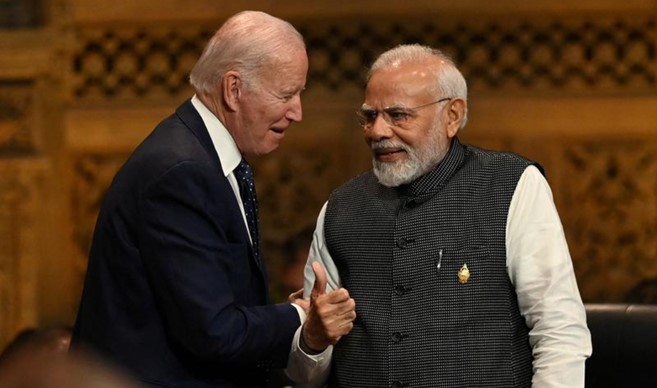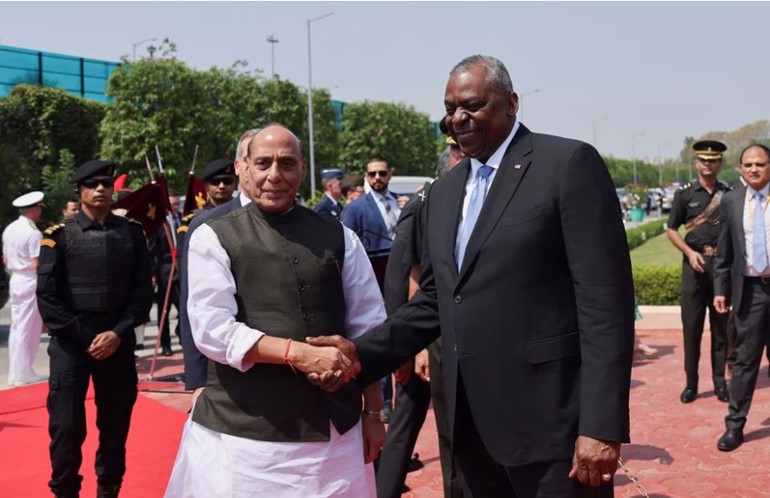The Centrality of the U.S.-India
Partnership to Maintaining Peace and Security in the Indo-Pacific Region
PDF Version
Dr. Indu Saxena | June 12th, 2023

“The United States and India’s relations is very important and underscored the centrality of U.S.-India partnership to maintaining peace and security in the Indo-Pacific region.” -Lloyd J. Austin
Over the past two decades, the relationship between the
United States and India has grown stronger, entering a new era of “global strategic
partnership”.1 This convergence is significant given the changes in
regional and global power dynamics. The two countries have collaborated in
numerous areas, including trade and investment, defense and security, climate
and clean energy, health, education, cyber, space, and technology. Bilateral
trade, defense, security, and technology cooperation have been the most
critical factors in advancing the relationship.2 Recent visits by
top officials, including Defense Secretary Austin’s visit to India in early
June and Modi’s upcoming official state visit to the U.S. on June 22, will
further strengthen the bilateral relationship and will reaffirm the shared
commitment to a free and open Indo-Pacific. However, Despite the increasingly
positive and collaborative trend in the relations between the two countries,
managing China in the Indo-Pacific and India’s alignment with Russia are the
prominent factors that make some analysts emphasize on India is ‘bad bet’ and
or ‘India’s last best chance.’
In the list,
senior expert Ashley J. Tellis has viewed India as a ‘bad bet’ for the U.S., based on the fact that India will not be part of any U.S.
confrontation with China, unless it threats India’s own security. Another
analyst has suggested that; India choosing the West over Russia could make it a
great power while also cautioning that this is ‘India’s last best chance’
before the U.S. starts viewing it as a reliable partner. The alternative perspective
is that it is important to note that the U.S. is not reliant on India for
immediate support in a conflict with China. Additionally, the U.S. tends to
seek ways to reduce risk (de-risking) rather than completely sever
ties (de-coupling)3 with China; as Biden stated earlier, “need
not be a new Cold War.”4 Additionally, Secretary Austin said
recently in Shangri -la-dialogue, “Conflict is neither imminent nor
inevitable.”5 Also, the
U.S. Secretary of State, Blinken’s proposed plan to travel China on June 18,
aims to bring thaw in strained relations of both countries.
Notably, Secretary Austin unequivocally lauded India’s ‘tremendous
capacity’ during his recent trip to the country. He emphasized that the United
States and India, like-minded countries working on a common vision and shared
commitment to a free and open Indo-Pacific, can have a “lasting
effect.”
Of course,
it’s true that from Taiwan to Tawang (A town in India’s Eastern state Arunachal
Pradesh), India’s own security concerns come first and matter the most. India
may not step up with the US if China invades Taiwan or the South China Sea; however,
India is committed to upholding international norms and the UN Charter, which
protects the sovereignty and integrity of all countries. Furthermore, India’s
relation with China is at its lowest level after the Galwan clash in 2020, when
India sacrificed its 40 soldiers in a non-combatant ambush with China.6
In addition, India has another adversary Pakistan, its neighbor, which is in
everyday strife through Kashmir7 and is also a good friend of China.
Given these critical factors and the longstanding policy of non-alignment, the
partnership between the US and India is moving forward in a way conducive to
both countries.
A Leap in Defense, Security and Technology cooperation

The U.S.-India
defense and security partnership has grown tremendously and now India is US’s Major
Defense Partner.8 The two countries are hugely engaged in defense
trade and joint exercises with various levels of bi-lateral dialogues and
working groups. During the U.S. Defense Secretary Austin’s visit to India on
June 4-5, a new roadmap9 has been introduced for U.S.-India Defense
Industrial Cooperation. The aim is to expedite technology cooperation and
co-production in various areas, including air combat and land mobility systems,
intelligence, surveillance and reconnaissance, munitions, and the undersea
domain. A new initiative of India-U.S. Defense
Acceleration Ecosystem (INDUS-X) is to advance cutting-edge technology
cooperation that will promote innovative partnerships between U.S. and Indian
companies, investors, start-up accelerators, and academic research
institutions. The Secretary Austin underscored “the
centrality of the U.S.-India partnership to maintaining peace and security in
the Indo-Pacific region”.10 The Initiative on Critical and Emerging
Technologies (iCET)11 represents a joint and unwavering commitment
between the United States and India to accelerate collaboration in the areas of
artificial intelligence, quantum technologies, and the semiconductor supply
chain within the technology realm.
Upswing in Trade and Economic Sector
Trade and
investments are important components of the U.S.-India multi-sectoral
relations. Total bilateral trade between the two countries increased
tremendously from U.S. $20 billion in 2000 to US $175 billion in 2022.12
Many U.S. companies see India as a stable and growing market and enhance their
operations from India. Apple, and other big U.S. companies tend to boost their
production from India.13 The deal between Boeing and Air India is a
recent example of another huge collaboration between American and Indian companies
where Air India will buy 200 Boeing and Airbus Aircraft for a total of $ 45.9
billion.14 The economic and financial partnership between the U.S.
and India are moving ahead at a fast pace along with the flurry of visits of U.S.
Commerce Secretary and Treasury Secretary Gina Raimondo to India in Feb-March
2023, collaborating with the sidelines of G-20 Finance Ministers meetings
(FMMs).15 And, India’s Finance Minister, Mrs. Nirmala Sitaraman met
with US Treasury Secretary Janet Yellen, to discuss the shared interest of
deepening economic partnership. While she attended the Spring Annual meeting of
IMF and World Bank on her week-long visit to the US in mid-April 2023.16
Expectations and Reality
The
convergence between two countries in bilateral relations is a reality. At the
same time both countries committed to support the rule based international
order with free, and open Indo-Pacific. However, two factors are still creating
turbulence in the U.S.-India partnership. One is the way of managing China.
While U.S.-India bilateral convergence doesn’t necessarily mean convergence on
managing China in the Indo-Pacific, despite the growing tension between India and
China. India wants to avoid an escalation of the situation. After the Galwan
face-off in 2020, India-China relations are not ‘business as usual.’ Since
then, China’s threat has been ghosting India at its Eastern Border, viewing the
recent incidents; of China’s effort to rename 11 places in the state of
Arunachal Pradesh and China’s opposition to India’s Home Minister’s visit to
the region.17 On this, the US supports India and condemns using
military force to change the Status Quo by Beijing along the LAC. In February
2023, Senator Merkel introduced a bipartisan resolution reaffirming the US
recognition of Arunachal Pradesh as an integral part of India.18 At
the same time, it is also true that more assertive behavior by China in the
Himalayan region will ultimately result in deeper ties between the U.S. and India.
And second;
India’s approach toward the Russia-Ukraine war and its alignment with Russia.
India’s dependency on Russian arms and oil has been widely debated and
discussed in the post-Russia-Ukraine war discourse. However, India’s Prime
Minister Modi remarked that it’s not the ‘era of war’ and that the crisis
should end with ‘diplomacy’ and ‘dialogue.’ Furthermore, India has expanded its
military procurement sources to include France, Israel, Germany, and the UK,
alongside efforts to enhance its own domestic defense capabilities. As per a
2023 report by the Stockholm International Peace Research Institute (SIPRI),
Russian arms exports to India saw a considerable drop of 37%. This decline may
be attributed to the Russia-Ukraine war and the rise in Russian arms exports to
China by 37%.19 Additionally, the collaboration between Russia and
China could impede India’s future relations with Russia.
Still, the U.S.
and India need to work together on critical matters such as tariffs, market
access, and India’s eligibility for the U.S. Generalized System of Preference (GSP).
Addressing these issues is essential for the growth of the trade relationship
between the U.S. and India and the ongoing negotiations on the IPEF supply
chain agreement. This collaboration has the potential to further strengthen
trade relations and establish a robust supply chain, taking advantage of
India’s rapidly growing economy. With the world’s largest population of
individuals under 35 years old, which stands at an impressive 66%,20
India is a rising power, and this partnership is sure to yield significant
benefits for both nations.
Both
countries want to limit China’s sphere of influence and oppose any change in
status quo using military force in the Indo-Pacific region. Indo-Pacific is the
‘priority theater’ for the U.S., and India has a geo-strategically advantageous
position in the Indo-Pacific. India is a prominent member of the Quad, and India is also a member of the Indo-Pacific Economic
Framework for Prosperity (IPEF) to make the economies more connected,
resilient, clean, and fair. The shared
commitment to a free and open Indo-Pacific is the key to broader strategic
convergence in U.S.-India relations.
Conclusion
Despite the
gap between the U.S. and India’s policy towards managing China and Russia, the
US and India have worked for more robust economic, defense, and security
cooperation. The U.S. is India’s largest trading partner in 2022-23, and India
is a designated major defense partner of the United States. Both countries have
a comprehensive strategic partnership. President Biden said that “relationships
with India is the most consequential relationship that the United States has in
the world. And that still stands.” The United States and India have potential
to rewrite the history of their relationship with their foundational values of
freedom, liberty, rule of law to establish an equal, inclusive, and free and
open Indo-Pacific. Both countries should enhance multi-sectoral cooperation and
embrace the rising challenges of global economy and global order. The
much-expected visit of President Biden to India in September and President
Modi’s forthcoming State visit to Washington in June will boost the
relationship.
Author’s Biography:
Dr. Indu Saxena is a senior expert and
fellow at the Consortium of Indo-Pacific Researchers. She writes on U.S. India Relations,
South Asia, and Indo-Pacific Security.
References
1.Brief
on US-India relations, MEA, https://www.mea.gov.in/Portal/ForeignRelation/India_US_brief.pdf
2.
Ibid
3.
White House Briefing Room, Remarks by National Security Advisor Jake Sullivan
on Renewing American Economic Leadership at the Brookings Institution, April 27,2023,
https://www.whitehouse.gov/briefing-room/speeches-remarks/2023/04/27/remarks-by-national-security-advisor-jake-sullivan-on-renewing-american-economic-leadership-at-the-brookings-institution/
4.
“Biden sees no need for ‘a new Cold War’ with China after three-hour meeting
with Xi Jinping” CNBC News, Nov.14,2022.
5.
Speech, A Shared Vision for the Indo-Pacific’: Remarks by Secretary of Defense
Lloyd J. Austin III at the Shangri-La Dialogue, June 4,2023
6.
“Battle in the Himalayas,” The New York Times, July14,2020.
7.
“Are Pakistan India Relations are Doomed Forever,” Dawn, May 3,2023.
8.
US Security Cooperation with India, Fact Sheet, Bureau of Political and
Military Affairs, Jan.20,2021. https://www.state.gov/u-s-security-cooperation-with-india/
9.
Secretary Austin Concludes India Visit, News Release, DOD, June 5,2023 https://www.defense.gov/News/Releases/Release/Article/3416249/secretary-austin-concludes-india-visit/
10.
Ibid.
11.
White House Briefing Room, FACT SHEET: United States and India Elevate
Strategic Partnership with the initiative on Critical and Emerging Technology
(iCET), January 31,2023. https://www.whitehouse.gov/briefing-room/statements-releases/2023/01/31/fact-sheet-united-states-and-india-elevate-strategic-partnership-with-the-initiative-on-critical-and-emerging-technology-icet/
12.
India-US Trade, India Brand Equity Foundation, https://www.ibef.org/indian-exports/india-us-trade
13.
“From Apple to Boeing, India is being put to the test as China manufacturing
alternative,” CNBC News, March12,2023.
14.
“Air India places orders for 470 Boeing and Airbus aircraft,” CNBC, Feb.14,2023
15.
Secretary Raimondo Announces U.S.-India Semiconductor Supply Chain and
Innovation Partnership MOU in New Delhi, US Department of Commerce,
March15,2023.
16.
FM Nirmala Sitharaman to attend Spring Meetings of IMF-World Bank, Business
Insider, April 8,2023
17.
China renames 11 places in Arunachal Pradesh, Hindustan Times, April 4,2023
18.
Arunachal integral part of India: US lawmakers introduce bill condemning
China’s aggression, India Today, Feb.17,2023.
19.
“Surge in arms imports to Europe, while US dominance of the global arms trade
increases,” Press Release, SIPRI, March 13, 2023. https://sipri.org/media/press-release/2023/surge-arms-imports-europe-while-us-dominance-global-arms-trade-increases
20.
“Decent Work for Youth in India,” International Labor Organization (ILO), https://www.ilo.org/newdelhi/info/WCMS_175936/lang–en/index.htm